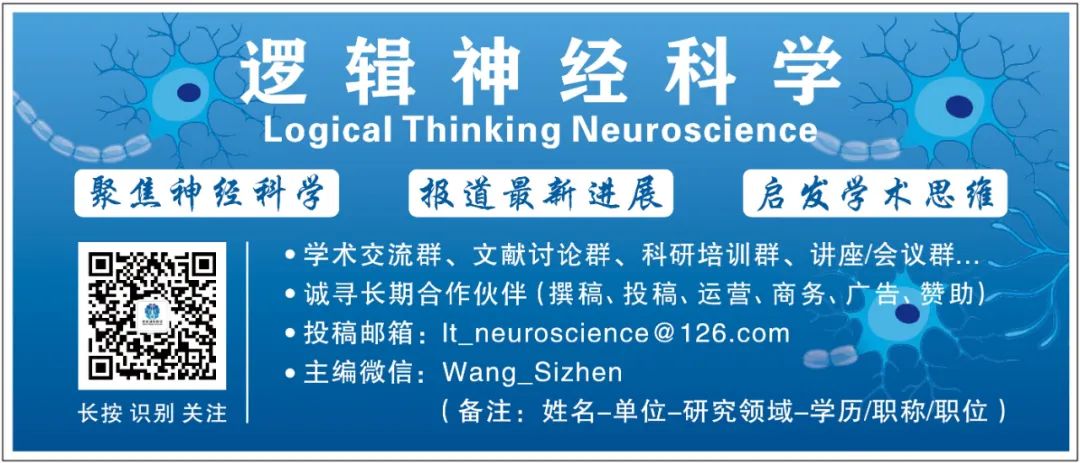
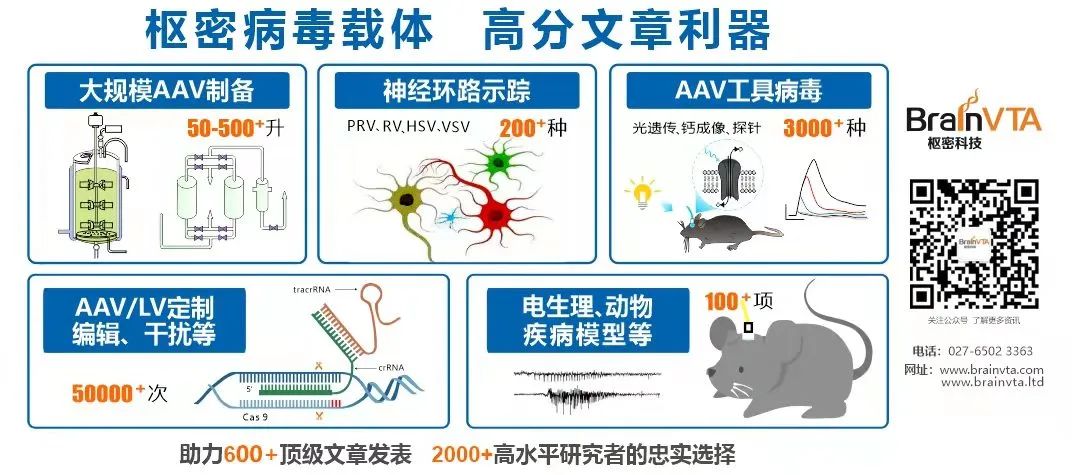
Authors: Ren Jingyuan, Luo Jin
Editor: Wang Sizhen
Since R. W. Sperry was awarded the Nobel Prize in 1981 for his research on split-brain studies, theories regarding the division of labor between the left and right hemispheres have had a profound impact, particularly in the realm of creative thinking, where many believe that creativity relies more on the functions of the right hemisphere.Despite previous studies providing unique insights into the hemispheric lateralization of creativity, several important questions remain unresolved.
First, it is unclear whether there is a division of labor between the two hemispheres in recognizing and processing the two most fundamental characteristics of creativity—”novelty” and “validity”.Second, previous studies employing methods such as “split-brain” and “brain injury” research, as well as “hemispheric crossed visual field” studies[1-4], have explored the unique functions of the left and right hemispheres by manipulating and controlling the input of information to one hemisphere, thus failing to adequately consider the competition and collaborative division of labor between the two hemispheres.Finally, previous research on hemispheric functional differentiation has typically examined overall functional differences between the left and right hemispheres, without adequately focusing on the lateralized functional differences of specific neural systems and networks closely related to creativity.
Previous studies have shown that the medial temporal lobe (MTL), including the hippocampus, asymmetrically participates in different stages and types of memory[9-14]. Moreover, recent research has increasingly pointed out that memory and creativity share numerous neural networks, particularly the MTL[15, 16], and damage to this brain region not only leads to episodic memory impairments but also significantly reduces an individual’s creativity. However, it remains unclear whether lateralization of MTL function exists in creative cognition.
To address this issue, researchers from the Key Laboratory of Learning and Cognition at Capital Normal University, the Donders Institute for Brain, Cognition and Behaviour in the Netherlands, and the Key Laboratory of Cognitive Neuroscience and Learning at Beijing Normal University collaborated to publish an academic paper titled “Functional lateralization of the medial temporal lobe in novel associative processing during creativity evaluation” online in Cerebral Cortex on March 30, 2022. This study reveals that the process of “generating” creativity in the mind and the psychological cognition and representation of the “novelty” characteristic of creativity rely more on the right hemisphere, particularly the right hippocampus; while the process of “evaluating” creativity in the mind and the representation of the “validity” characteristic of creativity rely more on the left hemisphere, particularly the left hippocampus. This deepens our understanding of the functional integration and separation of the left and right hemispheres in the creative cognitive process, providing new and more specific evidence to answer the question of the relationship between creative thinking and the left and right brains.
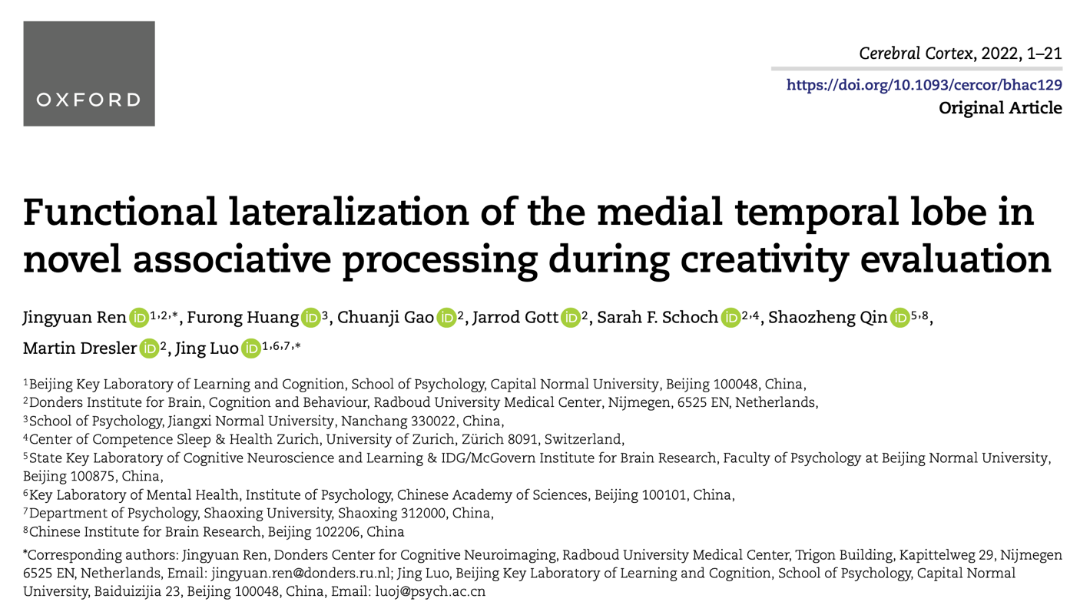
Using functional magnetic resonance imaging (fMRI), the researchers designed three types of stimuli from the perspective of the “novelty” and “validity” characteristics contained in creative thinking: “Functionally Useful (FU)”, “Novel but Useless (NS)”, and “Novel and Useful (NU)” (Figure 1A). They explored the signal responses, functional connectivity, neural representation patterns, and the relationship between brain and behavior in the left and right medial temporal lobes regarding the information processing preferences or sensitivities for the aforementioned two fundamental characteristics of creativity.
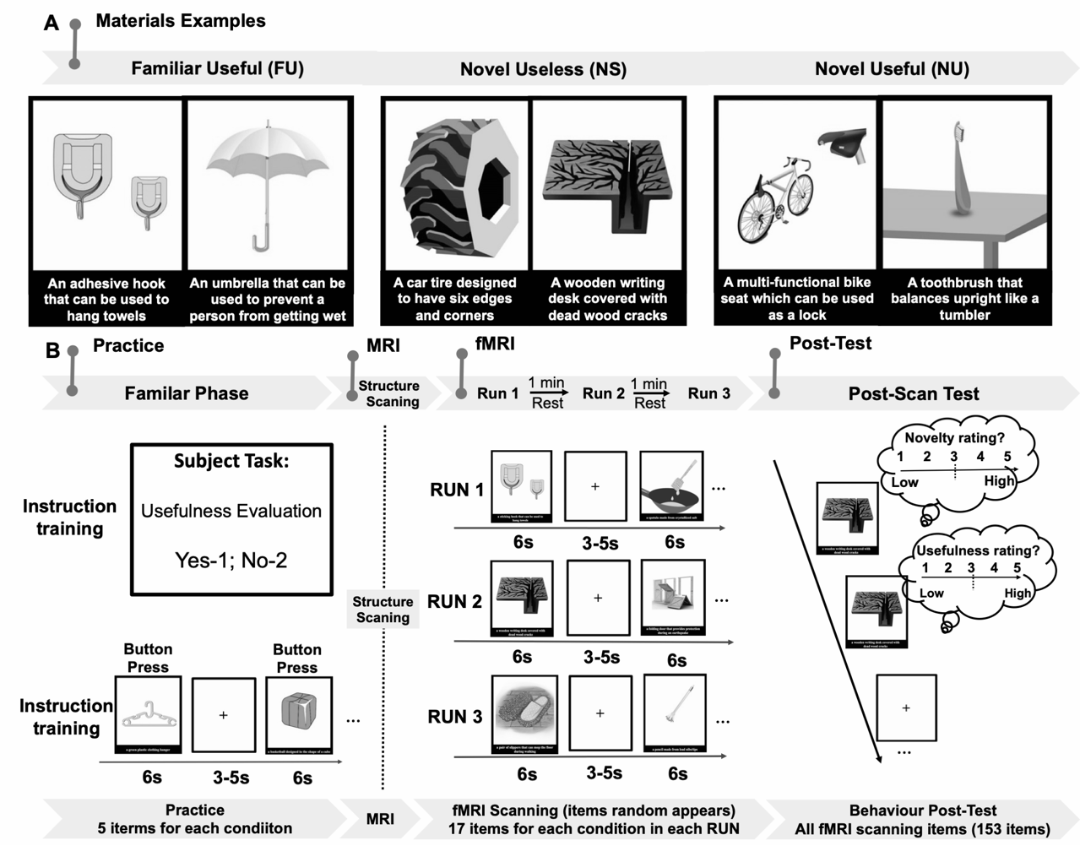
Figure 1 Materials and Experimental Procedure
(Image source: Jingyuan Ren et al. Cereb Cortex, 2022)
The researchers calculated the BOLD signal changes in the left and right MTL over time and found a separation in the sensitivity or preference for processing information regarding different validities of new stimuli (NU, NS) in the left and right MTL, specifically: the right MTL responds to both novel and useful stimuli and novel but useless stimuli; while the left MTL only responds to novel and useful stimuli. This indicates that: the right MTL may be “more tolerant” of novel but useless information; while the left MTL is “more stringent” regarding novel but useless information (Figure 2).
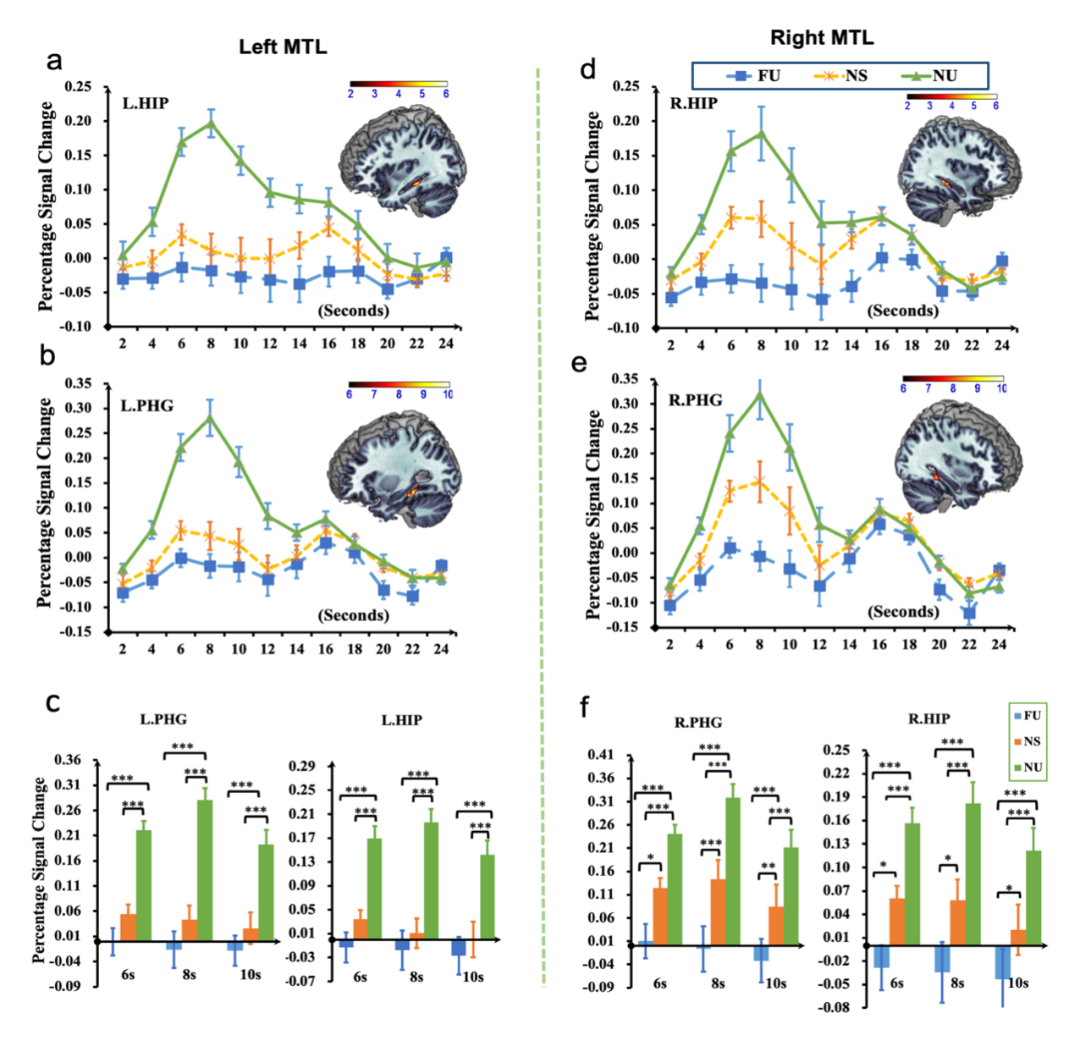
Figure 2 Time Series Separation of Responses in the Left and Right Medial Temporal Lobes to Different Validity New Stimuli
(Image source: Jingyuan Ren et al. Cereb Cortex, 2022)
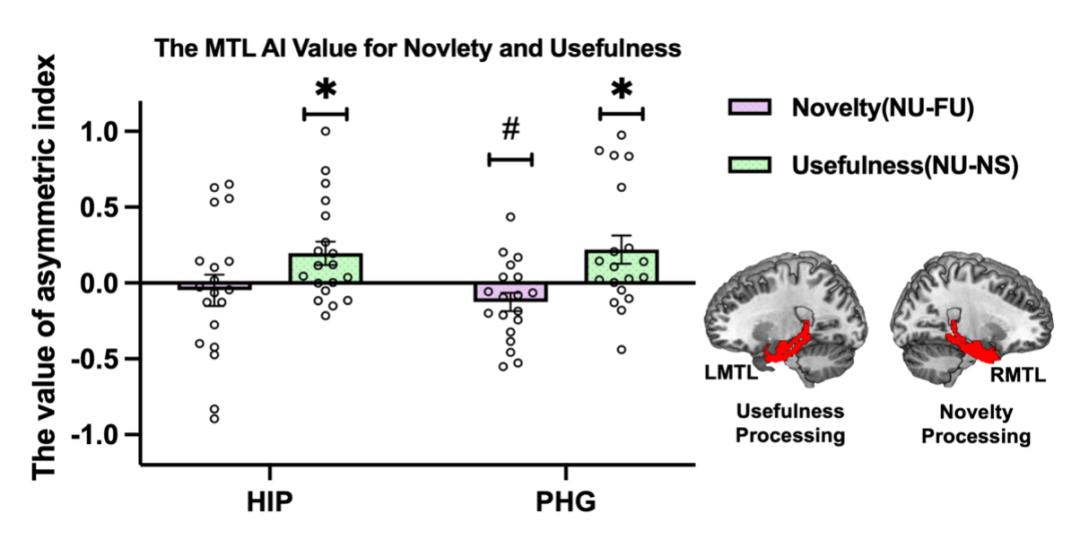
Figure 3 Lateralization of Processing in the Left and Right Medial Temporal Lobes During Novelty and Validity Representation Processes
(Image source: Jingyuan Ren et al. Cereb Cortex, 2022)
So, what is the reason for this functional separation in the left and right MTL during the processing of novelty and validity information? One hypothesis is that the processing of new information in the MTL is influenced by certain lateralized network systems in the brain, such as the executive control system and semantic concept system. To further explore whether the functional separation of the left and right MTL is influenced by the lateralization of other functional systems in the brain, the researchers conducted functional connectivity analyses of the left and right MTL and found that: the left and right MTL exhibit separable characteristics in functional connectivity when processing new stimuli of different validities; the left MTL (compared to the right MTL) shows stronger functional connectivity with the executive control system when processing low-validity novel stimuli (i.e., NS condition) than when processing high-validity novel stimuli (i.e., NU condition) (Figure 4A); while the right MTL (compared to the left MTL, no such functional connectivity was found in the left MTL) shows stronger functional connectivity with the emotional and reward systems when processing NS stimuli than when processing NU conditions.
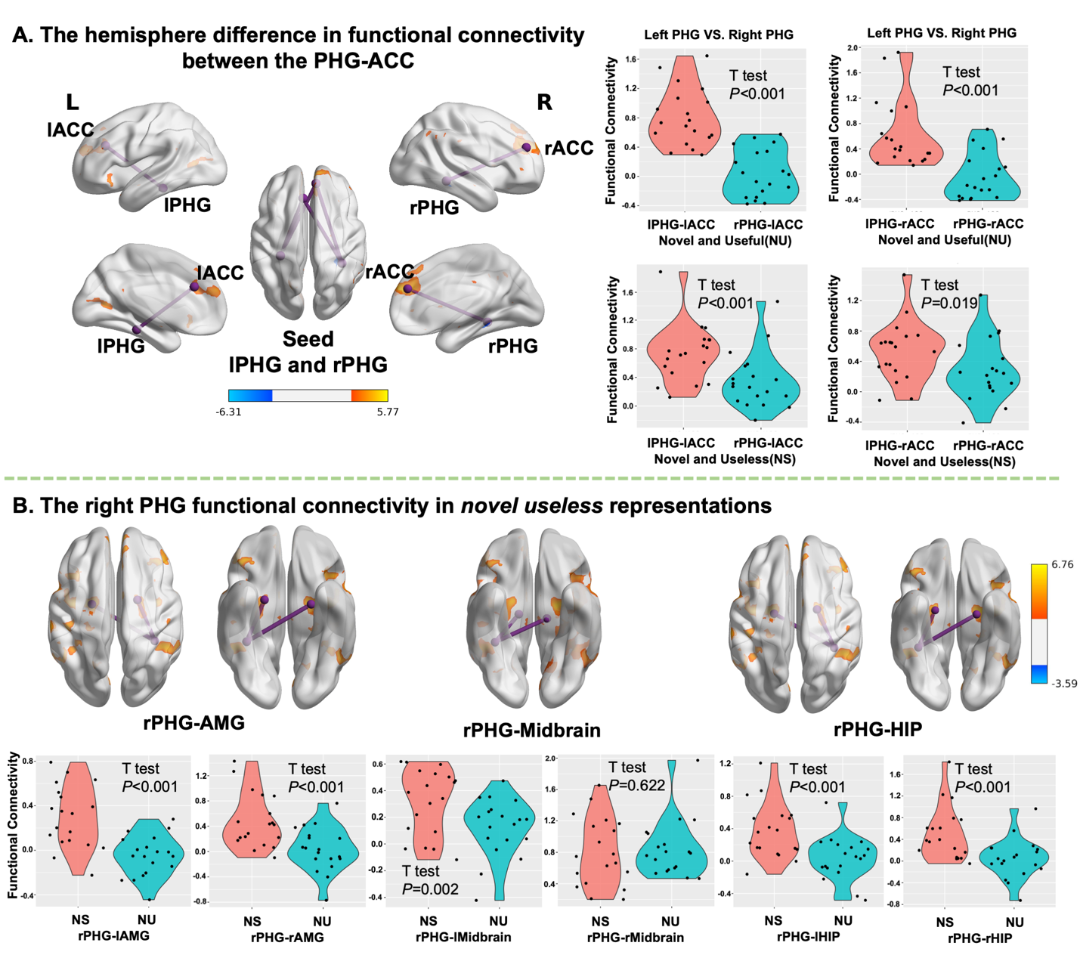
Figure 4 Functional Connectivity Separation in the Left and Right Medial Temporal Lobes During the Representation Process of Novel but Useless Stimuli
(Image source: Jingyuan Ren et al. Cereb Cortex, 2022)
At the same time, the researchers also examined whether the functional separation of the left and right MTL in processing new information is related to differences in the information encoding and representation patterns of the left and right MTL themselves. Through representational similarity analysis, they compared the differences in neural representation patterns of the left and right MTL when representing different novelty and validity stimuli. They also used a machine learning-based four-fold cross-validation method to explore the relationship between the representation patterns of new stimuli and behavioral evaluations. The results showed that: the left MTL is better able to accurately distinguish validity differences in novel stimuli (Figure 5A), and can behaviorally predict the validity and creativity ratings of novel and useful stimuli (NU) (Figure 5B).
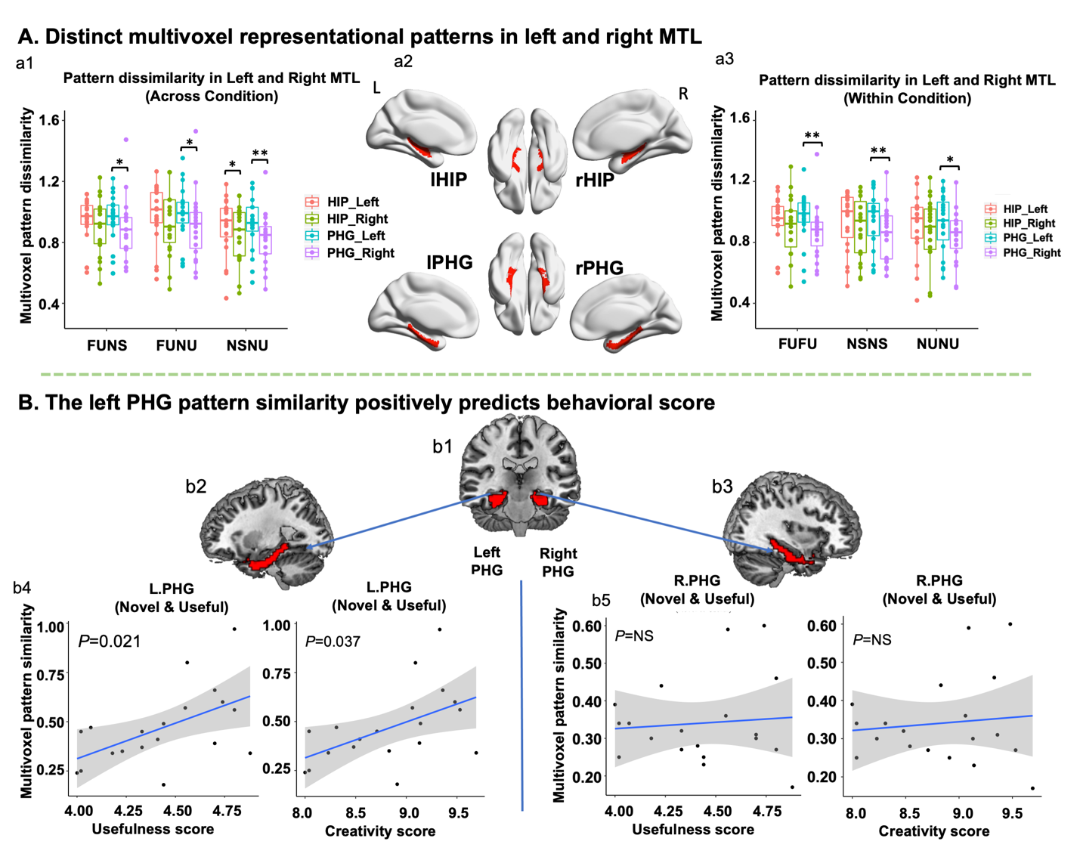
Figure 5 Neural Representation Pattern Separation in the Left and Right Medial Temporal Lobes
(Image source: Jingyuan Ren et al. Cereb Cortex, 2022)
In summary, the researchers believe that: the left and right MTL exhibit information processing preferences for novel stimuli, with the left side predominantly processing validity, being stricter in processing new information, while the right side predominantly processes novelty, being more lenient in processing new information, and this processing preference is jointly determined by the differences in functional connectivity between the left and right MTL with the executive control system and the emotional reward system, as well as the differences in the neural representation patterns of the left and right MTL themselves for new information.
Based on the above research findings, the researchers proposed a theoretical model for the evaluation of creative thinking processing in the left and right brains (Figure 6), which describes the functional differences between the left and right brains in processing novelty and validity during the creative evaluation process. It includes three processing stages and involves four main cognitive systems.
The Four Cognitive Systems in the Model of Left and Right Brain Mechanisms for Creative Evaluation
1. Novelty Connection System, primarily involving the MTL and adjacent hippocampal regions.Creative thinking involves the formation of “novel connections” and “creative conceptualization”[4, 17]. The “novelty connection” system mainly involves the formation of novel representations—broadly associating and reorganizing novel information, and associating semantic concept information through the hippocampus, with a relatively lenient acceptance standard for new information, exhibiting functional lateralization in the right hemisphere.
2. Semantic Concept System, which is crucial for the semantic concept processing of creative thinking. It involves the extraction, representation, association, and integration of semantic concept information during creativity generation and evaluation, breaking previous conceptual boundaries to form creative concepts, and is key to concept reconstruction. Creative concepts need to successfully integrate semantic concept information and reconfigure conceptual boundaries based on the newly formed novel connections. This process mainly involves the posterior middle temporal gyrus (pMTG), especially the left pMTG[4, 18], working in coordination with brain regions such as the hippocampus (HIP) and inferior frontal gyrus (IFG). Creativity relies on the reorganization of existing knowledge to generate novel and valid concepts. While both novelty and validity processing play crucial roles in the formation of new concepts and categories in creativity, validity processing tends to acquire meaningful semantic information during the conceptual processing, exhibiting functional lateralization in the left hemisphere.
3. Executive Control System, including the anterior cingulate cortex (ACC) and dorsolateral prefrontal cortex (DLPFC), primarily exhibiting functional lateralization in the left hemisphere. All processes of creative thinking evaluation are regulated by the executive control system. Our research indicates that the functional connectivity between the left MTL and the executive control system suggests that the left MTL dominates the processing of validity to filter, evaluate, and integrate novel meaningful associative information.
4. Emotional and Reward System, including the amygdala, hippocampus, and midbrain. In the creative evaluation process, the functional connectivity between the right MTL and the emotional reward system indicates that the MTL dominates novelty processing, adopting a more lenient acceptance standard for processing novelty and validity information, forming broad novel connections. These four cognitive systems collectively participate in the functional lateralization processing of novelty and validity information between the left and right hemispheres during the creative evaluation process.
The Three Stages of the Model of Left and Right Brain Mechanisms for Creative Evaluation
1. Creative Representation Stage—forming representations of creative designs, including the sub-stages of “Instantiation” and “Evaluation”. “Instantiation” is the external induction (through presented creative designs) that constructs the creative design in a person’s imagination, serving as a subjective form of visual representation generated in consciousness. “Evaluation” aims to assess the “novelty” and “validity” of the constructed imagery during the instantiation process. This evaluation process is dynamic: from “lenient” to “strict”, depending on the environment, individual differences, and hemispheric functional lateralization differences. An overly “strict” evaluation may lead to excessive rejection of creativity, while an overly “lenient” evaluation may increase acceptance of low-quality creativity. In this model, the left and right hemispheres participate laterally in the evaluation process based on “novelty” and “usefulness”, with the left hemisphere primarily responsible for “validity” evaluation, exhibiting stricter evaluation standards, while the right hemisphere primarily responsible for “novelty” evaluation, exhibiting more lenient evaluation standards.
2. Novelty Connection Stage—forming novel connections based on the evaluation standards of “novelty” and “validity”.The roles of the left and right MTL in processing novelty and validity differ. The right MTL primarily participates in novelty processing, with weaker differentiation of validity. It has functional connectivity with the emotional and reward systems, allowing it to broadly process new information while accompanied by positive emotional experiences. The left MTL primarily participates in validity processing, possessing stronger validity differentiation capabilities, and has strong functional connectivity with the executive control network (ECN) to filter, evaluate, and integrate novelty and validity. In this step, both hemispheres participate in the processing of novelty and validity information, but there are different priorities for processing novelty or validity information. When the left and right hemispheres coordinate their respective levels of participation in processing novelty and validity information, a novel association is formed.
3. Concept Boundary Reset—reconfiguring the conceptual boundaries of novel designs, including the conceptualization process of creative designs within novel connections. In this process, the conceptual boundaries of creative designs are dynamically adjusted based on the evaluated “novelty” and “usefulness” until the creative conceptualization is completed. After creative conceptualization, the conceptual boundaries of specific designs are fixed. Therefore, only truly novel designs—those that “break” familiar conceptual boundaries—can be considered genuinely “creative” designs. Through this process, the conceptual boundaries of “familiar designs” never change, as they merely serve as reference points for evaluating creative content. For novel designs (NS, NU), the conceptual boundaries dynamically change as their functions exceed the previous conceptual boundaries. However, novel but useless designs fail to achieve creative conceptualization due to their insufficient practicality to break the initial conceptual boundaries. In contrast, novel and useful designs successfully break this conceptual boundary. This process involves collaboration between the left pMTG and the semantic concept system[4].
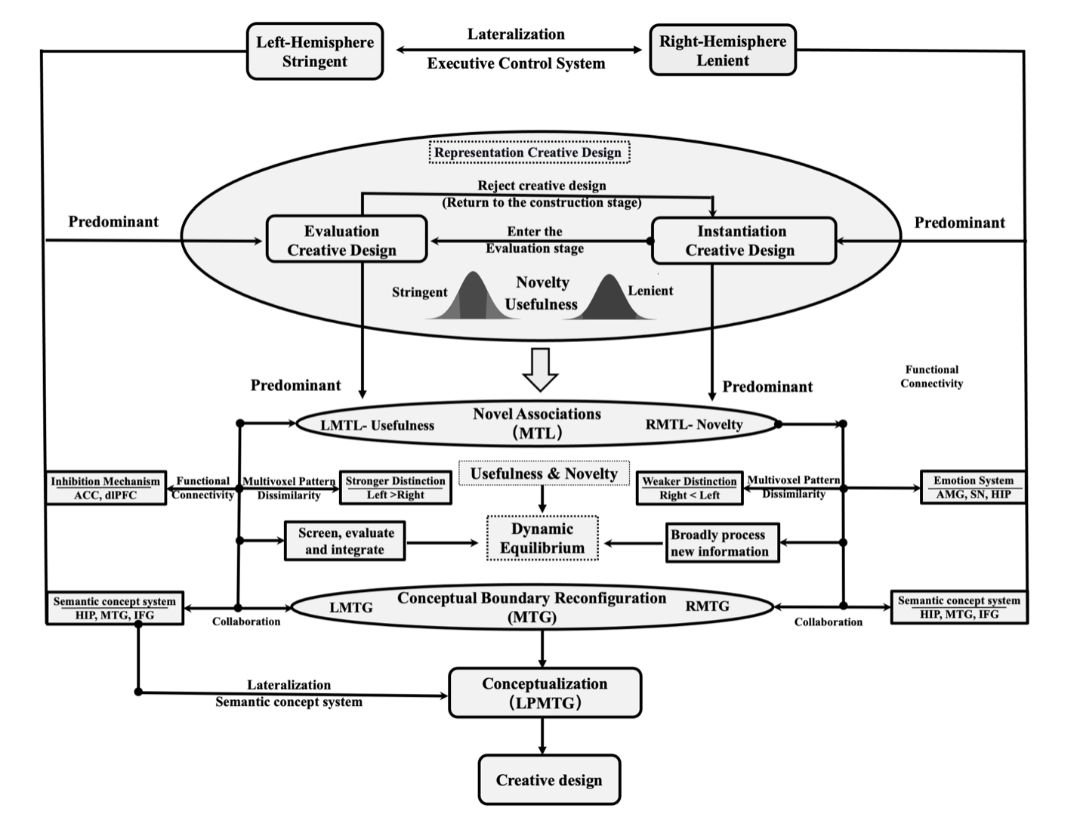
Figure 6 The Theoretical Model of Left and Right Brain Information Processing in Creative Thinking Evaluation
(Image source: Jingyuan Ren et al. Cereb Cortex, 2022)
Conclusion and Discussion, Inspiration and Outlook: In summary, this study indicates that the left and right brains exhibit unique functional lateralization for the “novelty characteristics” and “validity characteristics” of creativity, and this functional lateralization is mediated by differences in functional connectivity between the left and right medial temporal lobes (MTL) with the executive control system and emotional reward system, as well as differences in the neural representation patterns of the left and right MTL themselves for new information.
Researchers attempt to propose a theoretical model for the evaluation of creative thinking processing in the left and right brains (Figure 6), which clarifies the hypothesis of right-brain dominance in creativity to some extent, deepening the understanding of the functional integration and separation of the left and right hemispheres in the creative cognitive process, providing new and more specific evidence to answer the question of the relationship between creative thinking and the left and right brains, and offering scientific guidance for the cultivation of students’ creativity and brain function development.
Although this study explains the mechanisms of the left and right brains in the creative evaluation process to some extent, the hypotheses regarding the creative evaluation mechanisms focus on the MTL region of the brain. While the MTL has been shown to be closely related to creativity[4, 17, 19-22], given the complexity of creativity itself, the lateralized functional differences of other key brain regions involved in creativity (such as the MTG) also deserve further exploration.
Original link: https://doi.org/10.1093/cercor/bhac129

Corresponding Author: Luo Jin (left), First Author and Corresponding Author: Ren Jingyuan (right)
(Photo provided by: Luo Jin Laboratory, Capital Normal University)
Selected Previous Articles
[1] Cereb Cortex | Jin Haiyang et al. report the all-or-nothing neural mechanism of face classification: Evidence from N170
[2] eLife | Wu Wencan/Zhang Yikui/Hu Yang/Li Wei/Yang Jian collaborate on original large animal models and develop clinically translatable new strategies for local treatment of optic nerve
[3] Cereb Cortex | New mechanisms related to postsynaptic defects and abnormal behaviors associated with hyperactivity neuropsychiatric disorders: Sapap4 gene deletion
[4] PNAS | Kent State University professor reveals important regulation of brain cells controlling reproductive capacity
[5] Front Neurosci | Gender differences in bilateral caudate nucleus and posterior cingulate cortex in patients with depression
[6] PNAS | The neural mechanisms of calcium-activated potassium ion channel BK in absence epilepsy and movement disorders
[7] STAR Protocols | Protocol for studying the mechanisms of reward-seeking behavior in the brain through targeted drug delivery
[8] Nat Rev Neurosci Review | Li Yulong’s team invited to write a research review on new technologies for neurotransmitter detection
[9] Nat Commun | Guan Jisong’s research group discovers an important indexing mechanism for memory storage in the hippocampus
[10] Nat Commun | New advances in monitoring cortical activity in freely moving small animals: intelligent optical fiber two-photon microscopy
Recommended High-Quality Research Training Courses
[1] Patch Clamp and Optogenetics and Calcium Imaging Technology Seminar May 14-15 Tencent Meeting
[2] Research Skills | Fourth NIR Brain Function Data Analysis Class (Online: 2022.4.18~4.30)
[3] Research Skills | Introduction to Magnetic Resonance Brain Network Analysis Class (Online: 2022.4.6~4.16)
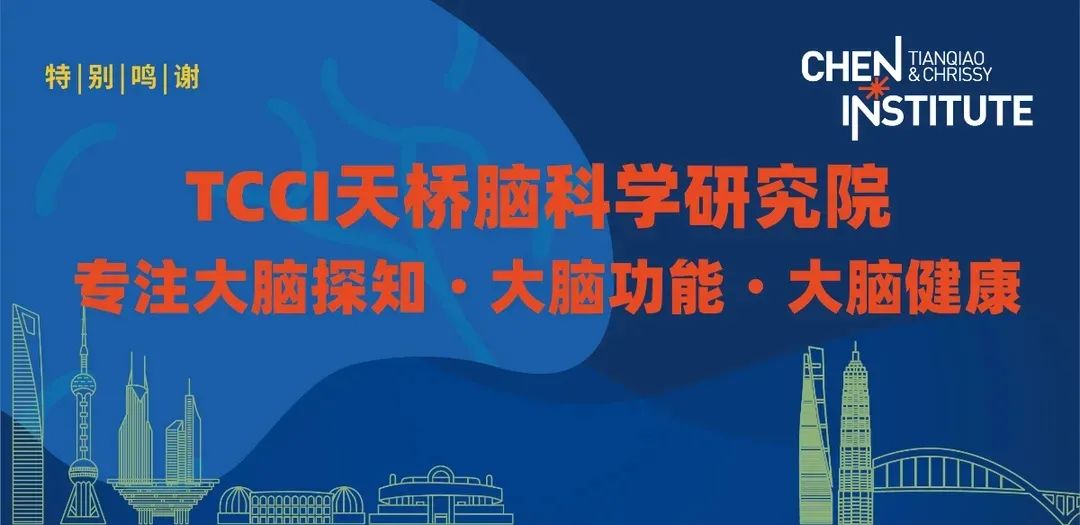
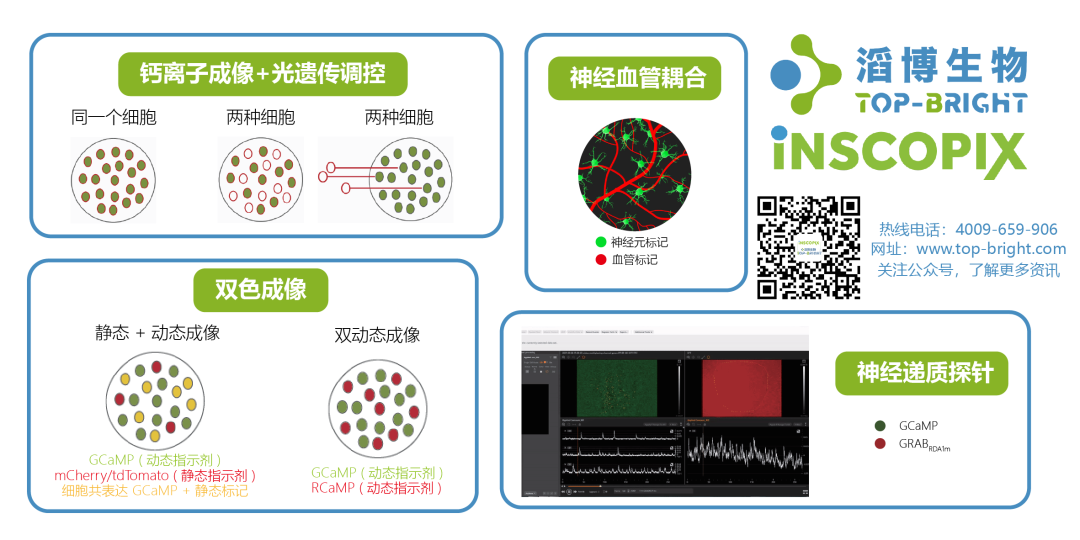
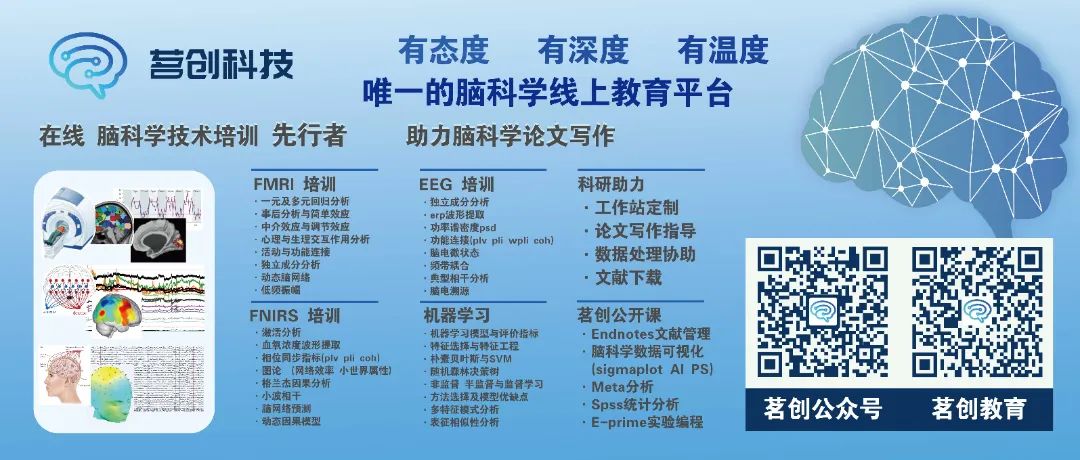
References (Scroll up and down to read)
1. M. A. Runco, G. J. Jaeger, The Standard Definition of Creativity. Creativity Res J 24, 92-96 (2012).
2. M. A. Runco, Creativity. Annual Review of Psychology 55, 657-687 (2004).
3. B. A. Hennessey, T. M. Amabile, Creativity. Annual Review of Psychology 61, 569-598 (2010).
4. Ren et al., The function of the hippocampus and middle temporal gyrus in forming new associations and concepts during the processing of novelty and usefulness features in creative designs. NeuroImage 214, 116751 (2020).
5. R. W. Sperry, Lateral specialization in the surgically separated hemispheres. The neurosciences third study program, 5-19 (1974).
6. M. S. Gazzaniga, Forty-five years of split-brain research and still going strong. Nature Reviews Neuroscience 6, 653-659 (2005).
7. M. Beeman et al., Summation priming and coarse semantic coding in the right hemisphere. Journal of cognitive neuroscience 6, 26-45 (1994).
8. M. J. Beeman, E. M. Bowden, M. A. Gernsbacher, Right and left hemisphere cooperation for drawing predictive and coherence inferences during normal story comprehension. Brain and language 71, 310-336 (2000).
9. A. Martin, Automatic activation of the medial temporal lobe during encoding: Lateralized influences of meaning and novelty. Hippocampus 9, 62-70 (1999).
10. L. Nyberg, A. R. McLntosh, S. Houle, L. G. Nilsson, E. Tulving, Activation of medial temporal structures during episodic memory retrieval. Nature 380, 715-717 (1996).
11. L. Nyberg et al., General and specific brain regions involved in encoding and retrieval of events: what, where, and when. Proceedings of the National Academy of Sciences 93, 11280-11285 (1996).
12. E. Tulving, S. Kapur, F. Craik, M. Moscovitch, S. Houle, Hemispheric encoding/retrieval asymmetry in episodic memory: positron emission tomography findings. Proceedings of the National Academy of Sciences 91, 2016-2020 (1994).
13. A. J. Golby et al., Material-specific lateralization in the medial temporal lobe and prefrontal cortex during memory encoding. Brain 124, 1841-1854 (2001).
14. M. A. Dalton, M. Hornberger, O. Piguet, Material specific lateralization of medial temporal lobe function: An fMRI investigation. Hum Brain Mapp 37, 933-941 (2016).
15. K. P. Madore, P. P. Thakral, R. E. Beaty, D. R. Addis, D. L. Schacter, Neural Mechanisms of Episodic Retrieval Support Divergent Creative Thinking. Cerebral Cortex 29, 150-166 (2017).
16. R. E. Beaty, P. P. Thakral, K. P. Madore, M. Benedek, D. L. Schacter, Core Network Contributions to Remembering the Past, Imagining the Future, and Thinking Creatively. J Cogn Neurosci 30, 1939-1951 (2018).
17. Z. Zhang et al., The function of medial temporal lobe and posterior middle temporal gyrus in forming creative associations. Hippocampus 30, 1257-1267 (2020).
18. W. Shen, Y. Yuan, C. Liu, J. Luo, The roles of the temporal lobe in creative insight: an integrated review. Thinking & Reasoning 23, 321-375 (2017).
19. D. J. Palombo, M. M. Keane, M. Verfaellie, The Medial Temporal Lobes Are Critical for Reward-Based Decision Making Under Conditions That Promote Episodic Future Thinking. Hippocampus 25, 345-353 (2015).
20. J. T. Wixted, L. R. Squire, The medial temporal lobe and the attributes of memory. Trends Cogn Sci 15, 210-217 (2011).
21. J. Luo, K. Niki, Function of Hippocampus in “Insight” of Problem Solving. Hippocampus 13, 316–323 (2003).
22. R. Cabeza, M. Becker, S. W. Davis, Are the hippocampus and its network necessary for creativity? Proceedings of the National Academy of Sciences 117, 13870-13872 (2020).
Layout by: Wang Sizhen
This article is complete